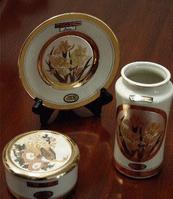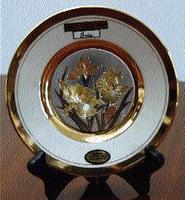

Junior Dowie/Staff Photographer Chokin is the ancient Japanese art of engraving copper and gilding it with precious gold and silver.
The engravings were originally created to decorate the shrine, temple and the armament of the samurai warriors, but the technique has been employed in many different areas, including plate ware.
Items are gilded with 24K gold and silver in designs which strike the eye from any corner of a room. Some persons are not just using their chokin art wares as part of their home decor, they are into serious collections. And if you want to become a collector or to be like many others who use them as accent pieces, just head for the jewellery stores in the plazas uptown and you will find some beautiful pieces.
Chokin is said to be a variant of Japanese damascene as applied to decorate swords, mirrors and other articles.
Metal techniques
In Japan, decorative metal techniques came with the arrival of aristocratic culture and taste from the Korean peninsula, and were nurtured by the Japanese imperial court as well as by Buddhism.
Damascene, in particular, as sword guards and fittings, is considered a major Japanese metal art and is widely collected.
The making of gold leaf and the seemingly countless grades (actually about 15 for each category of shape) of tiny gold bits, nuggets, flecks, flakes, squares, rectangles, splints, slivers, and the like, used to make gold lacquer decoration reflect the amazing development of this decoration in precious metal.
The technique of damascene was brought to Japan along with Buddhism through the Silk Road, a trade route in Japan. Damascus, Sylia, is recognised as the cradle of damascene.
This historic technique is used for accessories and ornaments which, as we said, are coveted collectibles.
- Outlook Team

